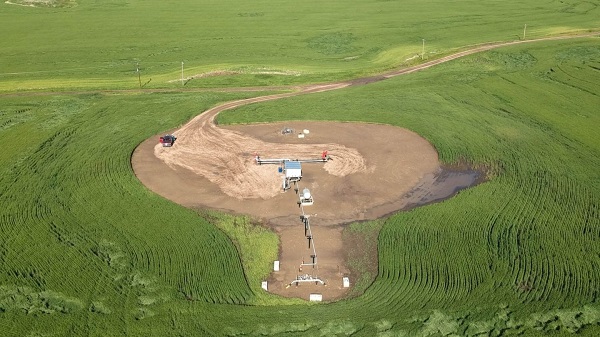Alberta
Province introduces civilian oversight of RCMP in Alberta: Committees to oversee RCMP service delivery

Alberta’s government is making sure communities have a say in how they are policed by the RCMP.
Ensuring Albertans are kept safe is a priority for Alberta’s government, which is why it introduced and passed the Police Amendment Act, 2022 in the fall session of 2022. This important piece of legislation is strengthening RCMP ties to the communities they serve and improving police accountability by mandating civilian governance bodies for municipalities policed by the RCMP. An order in council for the legislation was signed today, with the new regulations coming into force March 1, 2025.
The creation of the municipal and regional policing committees and the Provincial Police Advisory Board will ensure large and small municipalities have a role in setting province-wide policing priorities and performance goals for the RCMP to ensure service delivery reflects and addresses local needs.
The changes coming into force through the amendments and new regulations represent a collaborative effort on the part of municipalities, the RCMP and Alberta’s government to improve public safety in communities throughout the province.
“By creating new civilian governance bodies, we’re responding to Albertans’ long-standing desire for more say in how the RCMP police their communities while advancing a paradigm shift that sees local police across the province as an extension and a reflection of the communities they serve. Unique communities have unique public safety priorities and the creation of civilian governance bodies will address this issue. Creating mandatory civilian governance bodies also ensures accountability, as officers will be held responsible for their actions and behaviour.”
“Amendments to the Police Act support your Alberta RCMP’s ongoing efforts to ensure that communities have a strong voice in their policing priorities. In particular, it will assist our work on local resourcing, responding to calls for mental health and addictions issues, targeting prolific offenders, and dealing with hate crimes. The Alberta RCMP welcomes any changes or enhancements to oversight and governance that help us meet the needs of the communities we serve.”
“Our association’s 265-member communities welcome the provincial government’s effort to build stronger ties between the RCMP and the communities they serve. We hope these policing committees and the Provincial Police Advisory Board lead to improved public safety in communities throughout Alberta.”
Municipal and regional policing committees
Communities with municipal policing contracts and populations of more than 15,000 will be required to appoint municipal policing committees to oversee RCMP service delivery for their area. These committees will work with elected municipal officials to set policing priorities for the community, report on initiatives to support those goals, and create safety plans with their local RCMP detachments, authorities and agencies.
RCMP-policed communities with populations between 5,000 and 15,000 will be represented by regional policing committees to which they will be required to recruit and appoint members. These civilian committees will represent the interests and concerns of the public to the RCMP leadership in their district, work with local officials to identify and address public safety concerns for their region, and report on the implementation of programs and services to address them.
The Provincial Police Advisory Board
Small and rural communities policed by the RCMP with populations under 5,000 will be represented by a new advisory board. The Provincial Police Advisory Board will represent the interests and concerns of Albertans in these communities, support integrated safety planning and liaise with Alberta’s government, the RCMP and municipalities to align policing priorities and resources to help address local concerns and challenges. The 15-person board will include dedicated seats for representatives from Alberta Municipalities, Rural Municipalities of Alberta, and First Nations and Métis communities, as well as community representation for each of the province’s RCMP districts.
Quick facts
- The Police Amendment Act, 2022 received royal assent on Dec. 15, 2022, with the aim of improving police accountability, strengthening ties with communities and enhancing public confidence by reforming existing policing practices.
- The Police Amendment Act, 2022 made a number of amendments to the Police Act, including the creation of civilian governance bodies in jurisdictions policed by the RCMP.
- The Public Safety Statutes Amendment Act, 2024 received royal assent on May 16, and included amendments that allow for the regulation of municipal police committee memberships.
- Both the Police Amendment Act, 2022 amendments and the new regulations created to support these municipal and regional civilian governance bodies will come into force on March 1, 2025.
Related information
Agriculture
Lacombe meat processor scores $1.2 million dollar provincial tax credit to help expansion

Alberta’s government continues to attract investment and grow the provincial economy.
The province’s inviting and tax-friendly business environment, and abundant agricultural resources, make it one of North America’s best places to do business. In addition, the Agri-Processing Investment Tax Credit helps attract investment that will further diversify Alberta’s agriculture industry.
Beretta Farms is the most recent company to qualify for the tax credit by expanding its existing facility with the potential to significantly increase production capacity. It invested more than $10.9 million in the project that is expected to increase the plant’s processing capacity from 29,583 to 44,688 head of cattle per year. Eleven new employees were hired after the expansion and the company plans to hire ten more. Through the Agri-Processing Investment Tax Credit, Alberta’s government has issued Beretta Farms a tax credit of $1,228,735.
“The Agri-Processing Investment Tax Credit is building on Alberta’s existing competitive advantages for agri-food companies and the primary producers that supply them. This facility expansion will allow Beretta Farms to increase production capacity, which means more Alberta beef across the country, and around the world.”
“This expansion by Beretta Farms is great news for Lacombe and central Alberta. It not only supports local job creation and economic growth but also strengthens Alberta’s global reputation for producing high-quality meat products. I’m proud to see our government supporting agricultural innovation and investment right here in our community.”
The tax credit provides a 12 per cent non-refundable, non-transferable tax credit when businesses invest $10 million or more in a project to build or expand a value-added agri-processing facility in Alberta. The program is open to any food manufacturers and bio processors that add value to commodities like grains or meat or turn agricultural byproducts into new consumer or industrial goods.
Beretta Farms’ facility in Lacombe is a federally registered, European Union-approved harvesting and meat processing facility specializing in the slaughter, processing, packaging and distribution of Canadian and United States cattle and bison meat products to 87 countries worldwide.
“Our recent plant expansion project at our facility in Lacombe has allowed us to increase our processing capacities and add more job opportunities in the central Alberta area. With the support and recognition from the Government of Alberta’s tax credit program, we feel we are in a better position to continue our success and have the confidence to grow our meat brands into the future.”
Alberta’s agri-processing sector is the second-largest manufacturing industry in the province and meat processing plays an important role in the sector, generating millions in annual economic impact and creating thousands of jobs. Alberta continues to be an attractive place for agricultural investment due to its agricultural resources, one of the lowest tax rates in North America, a business-friendly environment and a robust transportation network to connect with international markets.
Quick facts
- Since 2023, there are 16 applicants to the Agri-Processing Investment Tax Credit for projects worth about $1.6 billion total in new investment in Alberta’s agri-processing sector.
- To date, 13 projects have received conditional approval under the program.
- Each applicant must submit progress reports, then apply for a tax credit certificate when the project is complete.
- Beretta Farms has expanded the Lacombe facility by 10,000 square feet to include new warehousing, cooler space and an office building.
- This project has the potential to increase production capacity by 50 per cent, thereby facilitating entry into more European markets.
Related information
Alberta
Alberta Independence Seekers Take First Step: Citizen Initiative Application Approved, Notice of Initiative Petition Issued

Alberta’s Chief Electoral Officer, Gordon McClure, has issued a Notice of Initiative Petition.
This confirms a Citizen Initiative application has been received and the Chief Electoral Officer has determined the requirements of section 2(3) of the Citizen Initiative Act have been met.
Approved Initiative Petition Information
The approved citizen initiative application is for a policy proposal with the following proposed question:
Do you agree that Alberta should remain in Canada?
The Notice of Initiative Petition, application, and statement provided by the proponent are available on Elections Alberta’s website on the Current Initiatives Petition page.
As the application was received and approved prior to coming into force of Bill 54: Election Statutes Amendment Act, the Citizen Initiative process will follow requirements set out in the Citizen Initiative Act as of June 30, 2025.
Next Steps
- The proponent must appoint a chief financial officer within 30 days (by July 30, 2025).
- Once the 30-day publication period is complete and a chief financial officer has been appointed, Elections Alberta will:
- issue the citizen initiative petition,
- publish a notice on the Current Initiatives Petition page of our website indicating the petition has been issued, specifying the signing period dates, and the number of signatures required for a successful petition, and
- issue the citizen initiative petition signature sheets and witness affidavits. Signatures collected on other forms will not be accepted.
More information on the process, the status of the citizen initiative petition, financing rules, third party advertising rules, and frequently asked questions may be found on the Elections Alberta website.
Elections Alberta is an independent, non-partisan office of the Legislative Assembly of Alberta responsible for administering provincial elections, by-elections, and referendums.
-

 Alberta11 hours ago
Alberta11 hours agoAlberta Independence Seekers Take First Step: Citizen Initiative Application Approved, Notice of Initiative Petition Issued
-

 Crime10 hours ago
Crime10 hours agoNational Health Care Fraud Takedown Results in 324 Defendants Charged in Connection with Over $14.6 Billion in Alleged Fraud
-

 Health9 hours ago
Health9 hours agoRFK Jr. Unloads Disturbing Vaccine Secrets on Tucker—And Surprises Everyone on Trump
-

 Bruce Dowbiggin12 hours ago
Bruce Dowbiggin12 hours agoThe Game That Let Canadians Forgive The Liberals — Again
-

 Alberta1 day ago
Alberta1 day agoCOVID mandates protester in Canada released on bail after over 2 years in jail
-

 Crime2 days ago
Crime2 days agoProject Sleeping Giant: Inside the Chinese Mercantile Machine Linking Beijing’s Underground Banks and the Sinaloa Cartel
-

 Business1 day ago
Business1 day agoCanada’s loyalty to globalism is bleeding our economy dry
-

 armed forces1 day ago
armed forces1 day agoCanada’s Military Can’t Be Fixed With Cash Alone






